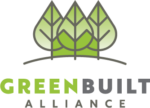The Road to Net Zero
Garret K. Woodward
I t’s beyond aesthetics and aiming to be sustainable — it’s the inevitable.
“The way everything is going in our world, people are starting to appreciate being sensitive to resource consumption,” said Emily Boyd. “People these days, who are going to build and buy homes, they’re more in tune with sustainable building — it can only be a growing segment of the market.”
Co-owner and designer at Mountain Sun Building & Design in Asheville, Boyd built a net-zero certified spec home in West Asheville. The house was the winner of the 2015 AHBA Parade of Homes “Green Home Award” and “Gold Craftsmanship Award.” And amid recognitions — the ENERGY STAR, EPA Indoor AirPlus and Green Built NC – net zero Energy Platinum Certification — Boyd and her co-owner husband, Jeb, simply believe in the idea of instilling sustainable building practices.
“We see sustainable building as the right thing to do,” Emily said. “It’s what we feel is responsible development. We’re not doing it because the market is asking for it. We’re doing it because it’s the right thing to do, and we want to push the market in that direction of sustainable building.”
A 1,953-square-foot three-bedroom abode, the home is at the crossroads of net-zero construction and having enough space to fit one’s lifestyle, an elusive square footage number that Emily deals with day in and day out when clients walk in the door. It’s making a cozy, sustainable home, and not cramming your existence into a shoebox-sized structure.
“You have to educate people. I don’t ask our customers to tell me how many square feet they want. I start by asking them how they live their life, and where they spend most of their time in the household, to figure out their square footage needs,” Emily said. “I find that people usually don’t have an accurate number of square feet they need, it’s usually a higher number than they have in mind. We try to tailor the square feet to their needs, but also have that space feel larger and more comfortable too — it’s about being smart with the use of square feet, every bit of it intentionally planned.”
And in an era of exponential interest in sustainable building, Emily emphasized the importance of truly knowing what “net zero” means, what the difference is when compared to other “green building” features that are often just diluted buzz words for marketing purposes. “There are a whole range of homes being marketed as ‘green homes,’ and what we try to do is hit the responsible way of doing things,” she said.
“There’s a lot of ‘green washing’ going on, and we try to educate consumers that there’s a lot of levels to it. We show them the Green Built NC checklist because that really explains just how deep the concept is, all the different categories for a built-from-scratch home and ways to make a conventional construction more sustainable — it’s better for the inhabitants, better for the environment, better for the community.”
Mountain Sun Building & Design focuses on the property itself, where they follow the contours of the landscape, looking for the best way to not only sit the house on the lot, but also make sure it ideally harnesses the natural resources available, whether it be solar orientation, access to water supplies, reclaimed wood from onsite, or merely taking advantage of the winter sun for passive heat with window placements.
“We’re very site specific, from the ground up,” Emily said. “We won’t design a house until we have a piece of property, because we want the site to respond to our design — what is the site telling us, and what does the homeowner ultimately want?”
When asked about the importance of doing your research and weeding through all of the terms, lingo, concepts and all things “sustainable,” Emily pointed out the importance of sitting down and discussing your vision — what you want and the budget — with a certified Home Energy Rater, something that will save you from future problems.
“There’s a lot of green literature these days,” she said. “You really need somebody who understands the process — the more efficient in your decision making and choices in the beginning, the easier it will all be down the road.”
You can also view this article as it was originally published on pages 14-15 of the 2016-2017 edition of the directory or as a pdf.

